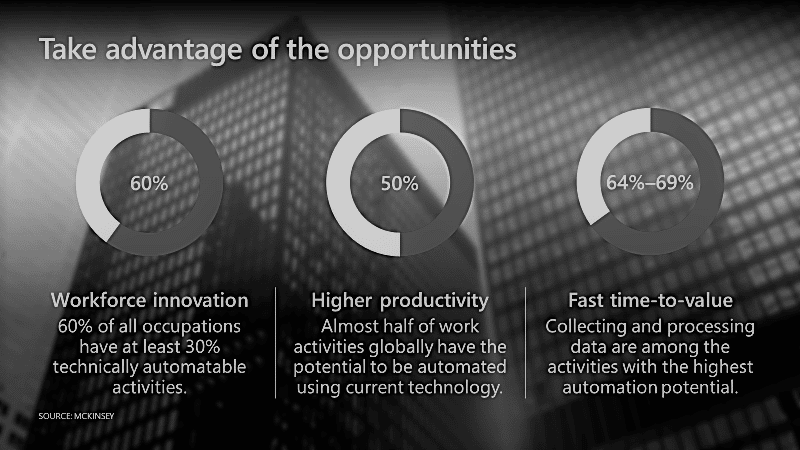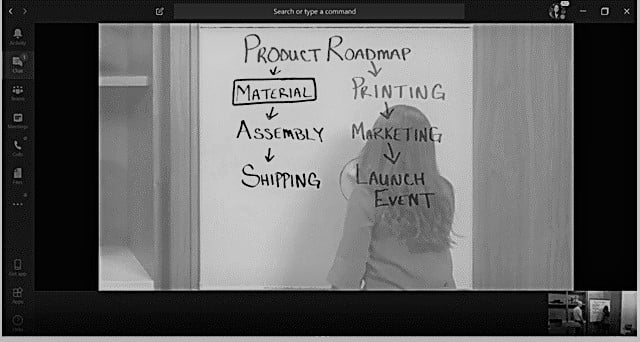Microsoft Ignite The Tour, London 2020
Last week, I attended ‘Microsoft Ignite The Tour’ conference at the ExCel where Microsoft was showcasing a range of its latest cloud technologies and developer tools. Primarily targeted at developers and system administrators, there were over 5,000 attendees from a wide variety of business sectors.
First up I went along to see Emanuel Carza from the Dynamics team present ‘Automating the workforce using Microsoft Power Automate’
He showed the slide below and introduced us to the Microsoft Power Automate tool which aims to deliver more business value by facilitating this automation and importantly freeing up employee’s time to do other, potentially more impactful tasks.
The tool is cloud based so it can automate at scale. Using something called AI builder, it is also possible to gain knowledge from unstructured data which was demonstrated by training a machine learning model to recognize a particular document style. Using a Power Automate flow, Emanuel was able to extract data from an e-mail attachment that had the same style as the trained model which was stored in the Common Data Service. This flow then generated an approval workflow which was integrated into Microsoft Teams.

Smarter retail
On I ventured into ‘The Hub’ to see some of the exhibitors, I found the Intel/Microsoft/Neal Analytics project really interesting. Using a combination of a Microsoft Surface Studio, camera and the Microsoft Azure Edge Stack powered by Intel processors, it is possible to revolutionise the retail experience.
In the demo, a customer walks up to the Surface Studio, the Azure Edge Stack device utilises AI to determine whether the customer is new or returning through facial recognition. This information is sent to the store manager who will then deliver a personalised experience based upon this information. The AI will consider the returning customers purchase history to further tailor their experience and the AI doesn’t stop here. As we know well here at Ipsos Jarmany, data is only as good as its source. The dashboard shown on the screen has been enriched by using AI to count the stock of items to enrich the sales/stock data information.
Smarter meetings
By far the most popular session of the day was Intelligent Communications with Microsoft Teams presented by Angela Donohue. As a frequent user of Teams, I was aware of many of its capabilities – however Angela introduced me to something brand new.
Quite often in face-to-face meetings you might have some remote participants who are ‘dialling in’ and there is an unavoidable disconnect between those physically present and those who are not. Digital whiteboards have been generally available for a while in Teams meetings but physical whiteboards in meeting rooms aren’t going away. If a physical participant is standing in front of a whiteboard, the remote participant can’t see what’s on it.
The new Microsoft Teams Rooms Content Camera utilises cameras in combination with AI to make the meeting an inclusive experience for all – very cool!

Smarter IT operations
Another recent innovation on the Azure platform through the Intune product is Windows Autopilot. Microsoft have partnered with OEMs such as Dell, HP and Lenovo to allow new devices to be pre-configured with corporate images and set up for a new meaning IT can provision machines in minutes.
Another of my favourite presentations was Securing your cloud perimeter with Azure Network Security by the very amusing Albert Chew. Albert told us that with the shift of data from on-premise to the cloud mean network security practices from 10-15 years ago no longer cut it and organizations must be more proactive in protecting their data and infrastructure. They should embrace the Zero Trust Architecture which has a couple of key principles.
- Verify explicitly – this means we should make sure the user is really who they say they are by considering other factors such as their location or their device hygiene.
- Least privilege access this means only giving access to exactly what users need with no higher level of access than required.
Given the vast number of data breaches over recent years you should assume your personal information is out there.
Microsoft want us to embrace three tiers of protection with our applications in the cloud. Protect the application itself, sing something like a Kubernetes container or DDoS protection; protect the infrastructure using network security groups and finally use a cloud-based firewall such as Azure Firewall.
It’s not all about the technology
And finally, my favourite presentation of the day was ‘Learning from Failure presented by Gabriel Nepomuceno from the Microsoft UK One Commercial Partner Team. Inspired by the whitepaper How Complex Systems Fail by Richard I. Cook, MD, Gabriel explained that complex systems are never 100% reliable and catastrophe is always around the corner.
The Boeing B17 Flying Fortress was involved in a series of accidents during WWII. Other accidents like this had shown a similar series of events before the accident occurred. The pilot would land the plane but then suddenly, the landing gear would suddenly retract, and the plane would collapse onto the runway. On each occurrence, investigators looked for evidence of mechanical and electrical failure but were not able to find any. Every incident was attributed to pilot error – really?
There are four common traps we as humans fall into when managing incidents:
- Attribution to human error – As soon as we do this, we stop investigating further and fail to discover the root cause. In the case of the B17, the cause was a faulty design in the cockpit. Both the flaps and landing gear switches were less than an inch apart from each other, identical in appearance. This meant that when the flaps were being retracted by the pilot upon landing, they also accidentally retracted the landing gear.
- We talk about what didn’t happen instead of focussing on how the incident occurred
- We don’t consider the logical reasoning of the human at the time of the incident by using negative adverbs such as “carelessly” and “negatively”
- Mechanistic reasoning which makes us believe that once we’ve found the faulty human, we’ve found the problem
Closing thoughts
It was a thoroughly enjoyable experience which allowed me to develop my understanding of the Azure platform and has inspired me as to how I can implement some of these new technologies into my day to day work with my clients at Ipsos Jarmany. Oh and I do love a free t-shirt, I’m a developer after all…



